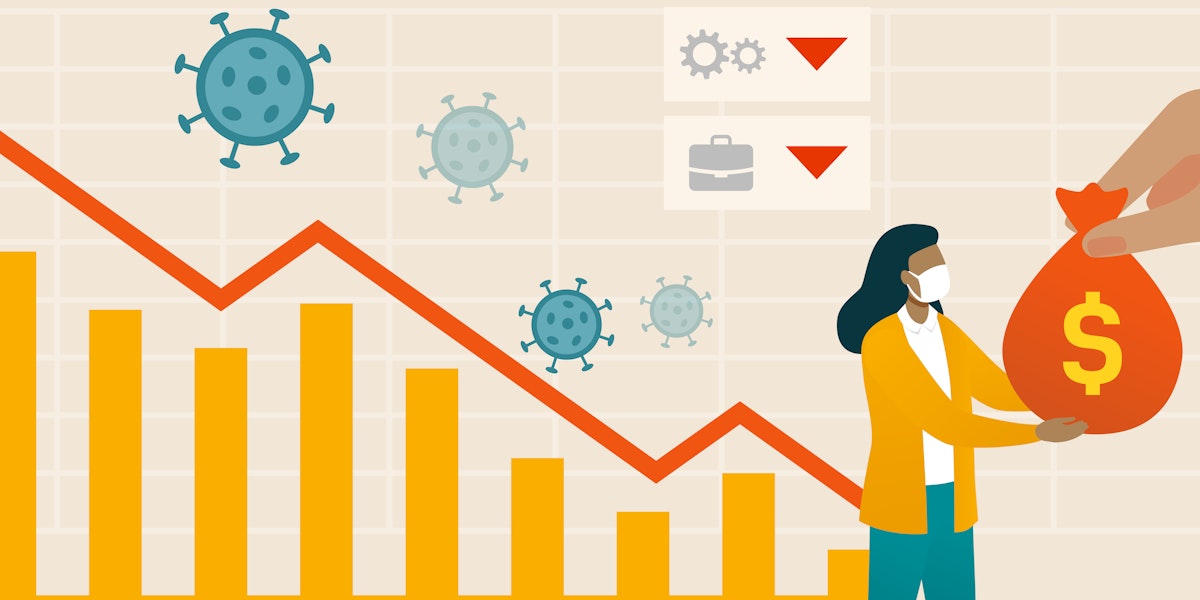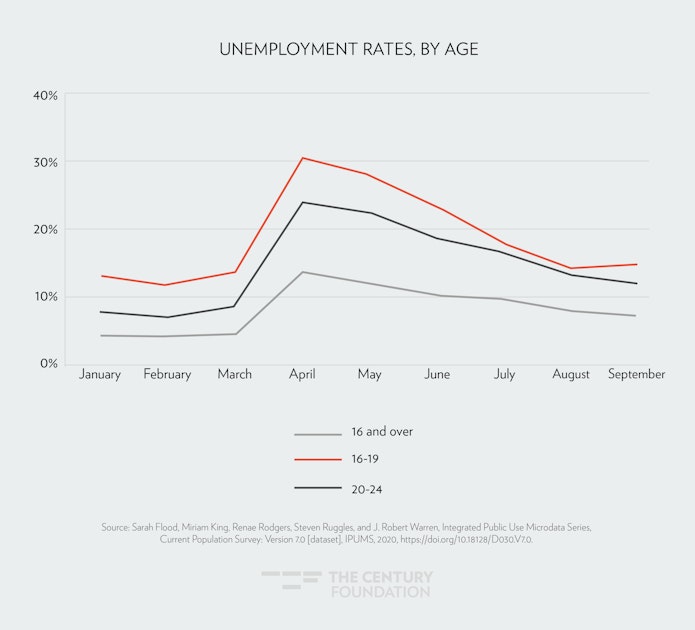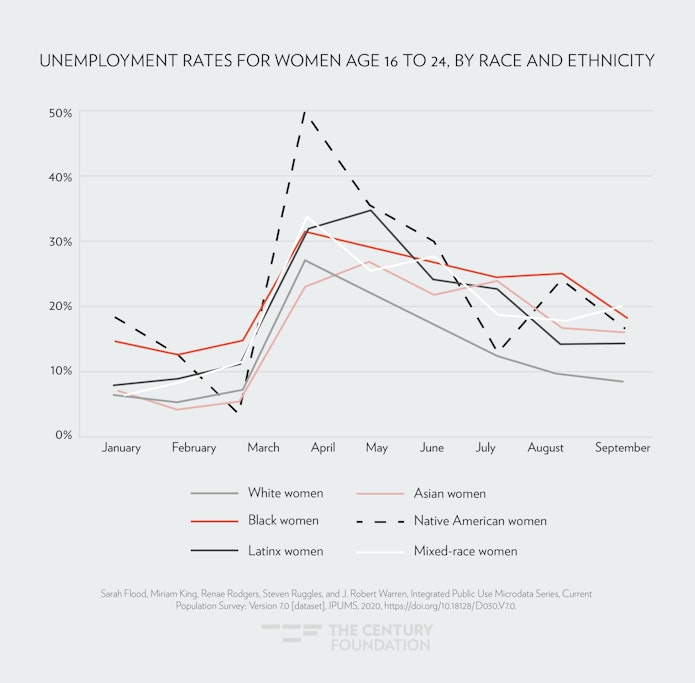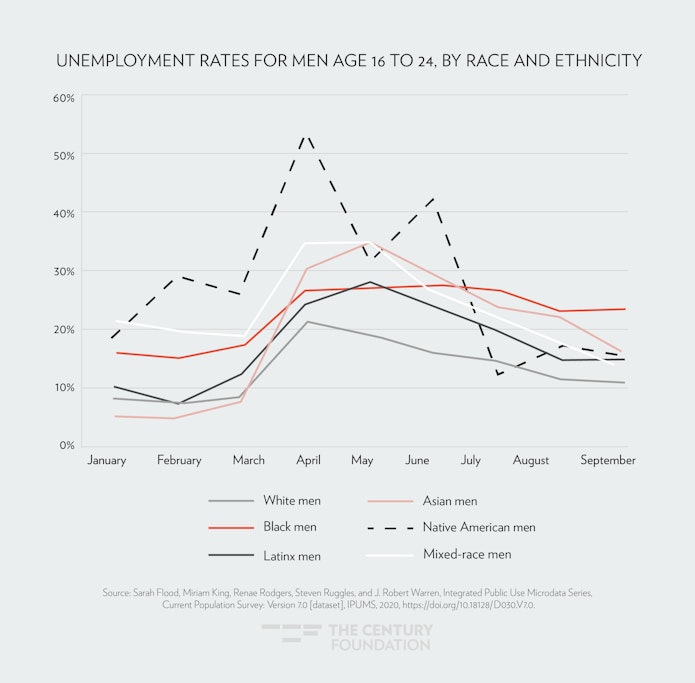In times of severe crisis, healthy societies tend to ensure their future by protecting the next generation—evacuating children from cities during wartime bombing, or, when a ship sinks, putting women and children in lifeboats first. America’s response so far to the COVID-19 pandemic appears to be different, however. Maybe because of a lack of preparedness, policymakers seem to be concerned mainly with rescuing older, more-established workers in a national economy teetering on collapse, with little thought to protecting teenagers and younger adults, who represent the economy that soon will be.
By design, as the nation’s economy went into freefall in a pandemic-induced recession, automatic stabilizers turned on, and policymakers crafted remedies. The size and duration of Unemployment Insurance benefits went up and were expanded for job losers. Gig and contract workers become eligible for benefits they didn’t have access to in flush times. Workers Compensation assisted workers who got COVID-19 on the job. Personal protective equipment (PPP)—a must in the workplace during the pandemic—went to employers and the employed. Moratoriums on evictions were placed. The IRS extended the traditional April 15 tax filing deadline to July.1 The Federal Reserve established several funding, credit, liquidity, and loan facilities.2
All these measures, however, were to preserve and protect the present and future of already established workers and their families. Youth, especially minority youth, received less attention than these groups during the pandemic. But youth who were already working, in school, graduating, and attempting to enter the labor force have been incredibly impacted by the pandemic and risk suffering a lifetime of economic loss. There is a large literature that documents significant and permanent “scarring” associated with recessions. The “scarring” occurs in the form of losses in employment and earnings that hit young people who enter the labor market during the recession. These losses are never fully recouped. Most recently, Jesse Rothstein finds that during the Great Recession, the employment rates of recent college graduates fell more than those of more experienced workers, and these declines in employment continued into the recovery.3 Based on his findings, and previous research, Rothstein fears that 2020, 2021 and even 2022 college graduates will experience permanent employment scars.4
The damage done to young workers by recessions does not bode well for out-of-school youth and those with no more than a high school degree. Since they have the least amount of skills and competencies, prior to the pandemic, their unemployment rates already exceeded 20 percent, and their employment-to-population ratios were the lowest of many groups. The recovery from the Great Recession helped them, but even after over a decade of economic expansion, many young adults still faced barriers and problems, including poverty, discrimination, and greater involvement with the criminal justice system.5
The pandemic exacerbated young, unskilled workers’ labor market challenges. Many analysts hope for a V-shaped recovery from the pandemic-induced recession, but this is not the case. Since April, what appears to be the peak in the downturn, the overall unemployment rate has slowly trended down, from 14.7 percent to 7.9 percent in September. Over the same period, the teenage unemployment rate fell from 31.9 percent to 15.9 percent.6 The danger is that if the recovery slows and adult workers remain the priority for relief and recovery, youth could start their working careers at major disadvantages, because early job opportunities as teenagers and young adults are a critical launch pad to further education and higher lifetime income.
This report describes the labor market outcomes of 16 to 24 year olds from January 2020 to September 2020 using the micro data files of the Current Population Survey, and for young persons the Pulse survey through mid-July. Using the public use files of the Monthly Current Population Survey, we compare their labor market outcomes to those of individuals 25 years of age and over, with special attention to the most vulnerable to economic disaster: Black Americans, Latinx, Native Americans, and mixed-race youth. The report then discusses the types of assistance that would benefit young workers, particularly the most vulnerable, and concludes with a series of recommendations.
Why Young Workers Are Most at Risk
Young people are most likely to get jobs in the hospitality and leisure sectors and retail trade occupations—sectors that were devastated by shuttering in response to the pandemic. Table 1 shows that just prior to the pandemic’s start, 18 percent of 16 to 24 year olds were employed in food preparation and serving related occupations, 14 percent were employed in sales and related occupations, and 11 percent were employed in office and administrative support occupations.7 Many of these jobs cannot feasibly be done via remote work, and so their employment prospects plummeted. (Table 1 provides selected occupations; see Appendix Table 1 for more detail.) Young adults in Food Preparation and Serving Related occupations contracted by 33.0 percent in May, as compared to 27 percent for adults. The employment of young adults in Sales and Related Occupations also contracted by 33.0 percent in May, compared to 22.0 percent for older workers.
TABLE 1
| Occupation Distribution and Change from January to September 2020 by Age | ||||||||||
| Panel A: 16 to 24 Years of Age | ||||||||||
| Occupation | % of Total | Jan | Feb | Mar | Apr | May | Jun | Jul | Aug | Sep |
| Educational Instruction, and Library | 4% | -16% | 0% | -17% | -24% | -32% | -43% | -43% | -49% | -23% |
| Healthcare Practitioners and Technical | 3% | -9% | 0% | -13% | -19% | -16% | -29% | -16% | -14% | -1% |
| Healthcare Support | 4% | -8% | 0% | -18% | -19% | -27% | -32% | -28% | -13% | -3% |
| Food Preparation and Serving Related Occ’s | 18% | -5% | 0% | -14% | -30% | -33% | -31% | -29% | -24% | -12% |
| Building and Grounds Cleaning and Maintenance | 4% | 17% | 0% | -12% | -23% | -8% | 3% | 3% | 8% | 14% |
| Personal Care and Service | 5% | -8% | 0% | -9% | -28% | -30% | -13% | -12% | -16% | -7% |
| Sales and Related Occ’s | 14% | 3% | 0% | -14% | -29% | -33% | -29% | -20% | -22% | -10% |
| Office and Administrative Support Occ’s | 11% | -4% | 0% | -12% | -21% | -26% | -28% | -22% | -20% | -1% |
| Installation, Maintenance, and Repari | 3% | 4% | 0% | -18% | -22% | -29% | -29% | -23% | -16% | -10% |
| All Occupations | 100% | -3% | 0% | -17% | -27% | -28% | -28% | -22% | -20% | -8% |
| Panel B: 25 Years and Over | ||||||||||
| Occupation | % of Total | Jan | Feb | Mar | Apr | May | Jun | Jul | Aug | Sep |
| Educational Instruction, and Library | 6% | -1% | 0% | -8% | -13% | -17% | -20% | -21% | -17% | -10% |
| Healthcare Practitioners and Technical | 7% | 0% | 0% | -11% | -17% | -19% | -22% | -21% | -18% | -8% |
| Healthcare Support | 3% | 2% | 0% | -13% | -15% | -20% | -23% | -25% | -15% | -2% |
| Food Preparation and Serving Related Occ’s | 4% | -2% | 0% | -17% | -26% | -27% | -33% | -28% | -27% | -10% |
| Building and Grounds Cleaning and Maintenance | 4% | -4% | 0% | -11% | -18% | -23% | -26% | -24% | -21% | -5% |
| Personal Care and Service | 2% | 4% | 0% | -10% | -20% | -21% | -23% | -22% | -13% | -9% |
| Sales and Related Occ’s | 7% | 1% | 0% | -14% | -17% | -22% | -23% | -22% | -19% | -10% |
| Office and Administrative Support Occ’s | 10% | -1% | 0% | -10% | -15% | -19% | -22% | -19% | -13% | -7% |
| Installation, Maintenance, and Repair | 3% | -2% | 0% | -13% | -15% | -20% | -23% | -20% | -16% | -5% |
| All Occupations | 100% | -1% | 0% | -12% | -15% | -19% | -22% | -21% | -17% | -8% |
| Notes: The data come from the micro data files of the monthly household Current Population Surveys for January to September 2020. To be included in the sample the individual must be at least 16 years of age.
Source:Sarah Flood, Miriam King, Renae Rodgers, Steven Ruggles and J. Robert Warren. Integrated Public Use Microdata Series, Current Population Survey: Version 7.0 [dataset]. Minneapolis, MN: IPUMS, 2020. https://doi.org/10.18128/D030.V7.0. |
||||||||||
When the economy hit rock bottom in April and some jobs returned in May and June, these groups of young workers still suffered what in more normal times would be viewed as huge setbacks. Their cumulative job loss still exceeds that of adults, including staggering jobless rates for 16-to-24-year-old black women, Latinx women, and mixed-race women at or above 30 percent. For young men, these workers’ jobless rates were at or above 25 percent. Even as jobs came back from June to September, these young adults still suffer big losses relative to their pre-pandemic employment rates. The hardest hit sectors with youth concentrations are still well below their February levels.
The trends of regaining employment reflected in the May to September Current Population Survey led the Trump administration to make a big deal about the recovery, but this view was a pipe dream. In order for private sector employment to return to its February pre-pandemic level by the Bureau of Labor Statistics’ November jobs report, 9.8 million new private sector jobs would have needed to be created during October.8
Rapid employment recovery is highly unlikely, given recent patterns with COVID-19 health indicators. The resurgence of the virus has caused states to slow down the opening of their economies. Over thirty states have positivity rates that have a 10 percent or higher positivity rate over a seven-day rolling average.9 With the restart of K–12 schools and colleges and universities, rates of infection can only increase. This could slow down their re-opening and restart efforts with some communities shutting down. Nervous consumers may pull back consumption on their own.
What Happened to Young Workers during the Pandemic?
Figure 1 reports unemployment rates for January 2020 to September 2020 by age for respondents age 16 and over, age 16 to 19, and age 20 to 24. The estimates reveal several clear trends. Prior to the pandemic, youth have higher jobless rates than adults, especially teenagers. The latter’s rates already exceeded 10.0 percent, ranging from 11.5 percent in February to 13.4 percent in March. Regardless of age, the April unemployment rates—the first full month of the pandemic—jump by 10.0 to 19.0 percentage points for the three groups. The largest increases occur for youth. Although the May to September jobless rates for all age groups remain elevated, they do suggest a modest recovery may have started, as the rates for all groups trend downward. The adult rate falls below 10.0 percent, while the youth rates still exceed 10.0 percent.
FIGURE 1
Figures 2 and 3 provide a more disaggregated picture of young worker experiences during the pandemic recession for young adults (16 to 24 years of age), showing unemployment rates by gender, race, and ethnicity. Figure 2 reports the estimates for young women and Figure 3 reports estimates for young men. Regardless of gender, young black American and Native Americans start the pandemic recession with unemployment rates that exceed 10 percent. Similar to previous exhibits, all demographic groups experience major increases in their April unemployment rates. The increases are largest for young Native American men and women. Among women, the recovery since April is fastest for white women. The recovery looks slowest for minority women, whose jobless rate still exceeds 14.0 percent. For men, the data indicate a recovery of varying degrees for all young men, except black young men, whose jobless rate has not come down from its April value. Although other minority male jobless rates have trended down since April, they too remain in the 15.0 percent range. These trends are troubling because they could be the start of a common pattern, that youth unemployment rates remain elevated even as the economy starts to recover, in this case reopen.
FIGURE 2
FIGURE 3
Finally, Appendix Table 2 reports the unemployment rates for teenagers (16 to 19 years old) and young adults (20 to 24) by gender, age, race and ethnicity. The goal here is to explore whether teenagers and slightly older young adults have similar or different experiences with the pandemic recession, and whether the experiences differ by race and gender. The estimates show teens and slightly older young adults have similar patterns: peak in April and exhibit a slow or very little improvement in May to September. Teens and young adults have equally borne the brunt of the downturn. The estimates do suggest that young women, especially minority women, saw their jobless rates rise to higher levels. This confirms the characterization by Nicole Mason, president of the Institute for Women’s Policy Research, who referred to the pandemic recession as a “she-cession.”10 Women have borne a disproportionate burden of the downturn.
Youth Need Immediate Assistance
As was discussed earlier, adults have received the bulk of resources for relief and recovery from the pandemic. The most immediate need for young unemployed workers is unemployment insurance. The HEROES Act, which was passed in the House of Representatives, provides relief to the unemployed; however, it does nothing for young recent high school and college graduates who are attempting to enter the labor force. Our unemployment rate estimates for 20 to 24 year olds show that they are having greater difficulty than adults with finding employment due to the downturn. They do not qualify for assistance because their job and wage histories are nonexistent, too short, or too low. In order to prevent economic scarring, this year’s graduates should receive financial assistance even if their joblessness is not directly due to COVID-19 or related emergency orders.11
Young adults also need assistance with financing their education. The HEROES Act contains many good elements of support. The act expands temporary student loan interest and payment relief to federal borrowers excluded from the CARES Act. It extends the relief for all federal borrowers for an additional year. It provides a trigger to extend relief from interest accrual past the one-year time frame in the event of ongoing weak economic conditions. It prohibits the secretary of education from imposing eligibility restrictions that exclude undocumented students and other students from CARES Act emergency grants. It cancels debts of borrowers who were victims of predatory schools, and provides debt reductions to a subset of distressed borrowers. It supports student access to public higher education and minority-serving institutions by delivering aid to states conditioned on continued state funding of college access, and prevents scam online programs being financed by federal student loans by requiring courses to include regular and substantive interactions between instructors and students. Finally, the HEROES Act offers relief to nonprofit colleges in financial distress while requiring planning for potential closures or mergers.12
Although fairly comprehensive, the HEROES Act does not contain some key support mechanisms. For example, twenty-five higher education organizations and unions have asked for $46 billion in support for state public higher education budgets.13 This could help to reduce the magnitude of potential layoffs of teachers and staff. Further, Congress should do more to protect consumers from predatory schools by reinstating the Gainful Employment rule, closing the 90–10 loophole, and upgrading oversight and enforcement, including establishing a robust “mystery shopping” program to root out manipulative and unfair recruiting. Taking these steps will minimize job loss, especially at this critical part of one’s career. Specifically, the decline in life-time income will be dampened.
Young Black Americans Need Additional Support and Investment
Our evidence and the research of others demonstrates that racism continues to hinder Black Americans from successfully competing in the economy, creating immense challenges for Black youth in particular. Even though we are still in the relief and recovery phase with regard to the pandemic, the damage wrought underscores that the nation needs to begin reimagining how all Americans should live. With respect to young Black Americans, in addition to investments that benefit all lower- and moderate-income Americans, there needs to be a long-term post-pandemic comprehensive response that addresses systemic racism. This remedy would begin with “race neutral” strategies, such as investing in the nation’s human and social capital investments, improving opportunity, and lessening inequality, and then continue with “race specific” strategies associated with fighting discrimination.14
Building Human and Social Capital
Federal and state public investments in human and social capital should begin with expanding teenagers’ access to employment, internship, and volunteer opportunities, given the large literature that indicates a strong link between teenage employment and education, wages, and contact with the criminal justice system.15 Further investments should be made in career technical occupations, such as HVAC technicians and plumbers, especially because these jobs are less likely to be outsourced, providing greater economic security that many Americans crave.16 Policymakers, researchers, practitioners, current high school students, current college students, and recent graduates should be convened to identify and recommend ways to narrow the black-white wage gap among college graduates. Finally, state governments should reduce child support arrearages, while also building in mechanisms to preserve the noncustodial parent’s connection to their children.17
Improving Opportunity
To improve opportunities for young Black Americans, policymakers should increase access to education and training in many sectors, but particularly in “innovation” areas of the economy.18 Workforce development in innovation sectors should be funded by the Department of Justice’s (DOJ) forfeiture funds program, and explore whether the DOJ’s victim compensation and equitable sharing programs can be an additional source of funding for providing education and training to communities affected by crime, an approach consistent with the program’s goal to compensate victims with recovered assets.19 Prospective infrastructure plans should include education and training to ensure minorities and women are able to fairly compete for jobs.20 Further, reduce the barriers African Americans face when commuting or moving to suburban employment. Next, workers’ rights should be strengthened, including improving workers’ ability to bargain with their employers and granting freelancers and gig workers better protections. Finally, policy is needed to assist ex-offenders, especially nonviolent drug offenders, with returning to school, obtaining employment, driving and voting.
Improving Opportunity
To lessen inequality for workers in the United States, Congress should first increase the minimum wage to $15.00, create new work scheduling standards, and rigorously enforce wage laws aimed at preventing wage theft. Next, policy is needed to counter the Trump administration’s Labor Department attempts to undermine workplace safety and fairness measures, and advocates should begin to build a new labor policy based on the four features laid out by MIT’s Thomas Kochan and William Kimball.21 Next, elected officials must ensure that the Federal Reserve’s monetary policy targets full employment, with wage growth that matches productivity gains; the recently introduced Federal Reserve Racial and Economic Equity Act would make reducing inequality part of the Fed’s mission, and it would ensure that racial economic disparities are not ignored.22 Finally, reparations should be considered as a tool to lessen inequality in the United States and should stay in the national conversation.23
Fighting Discrimination
Fighting discrimination must be a focus of equalizing the playing field for young Black Americans. Although affirmative action policy has not changed in the current administration, the Trump administration DOJ withdrew Obama administration guidance documents that encouraged schools and colleges to promote diversity through their admissions process. Congress should request to reverse that decision because it sends the message that diverse learning environments are not valued. Finally, the Equal Employment Opportunity Commission needs more funding from Congress in order to adequately do its job in addressing discrimination by clearing large EEOC claim backlogs.
Click here to see Appendix 1
Click here to see Appendix 2
This research was funded by The Annie E. Casey Foundation, Inc., and we thank them for their support; however, the findings and conclusions presented in this report are those of the authors alone, and do not necessarily reflect the opinions of the Foundation.
Notes
- See for example, “CARES Act Section by Section,” Office of Congressman Tim Walberg, https://walberg.house.gov/sites/walberg.house.gov/files/CARES_Section_by_Section_FINAL.pdf.
- “Coronavirus Disease 2019 (COVID-19): Funding, Credit, Liquidity, and Loan Facilities,” Board of Governors of the Federal Reserve System, April 30, 2020, https://www.federalreserve.gov/funding-credit-liquidity-and-loan-facilities.htm.
- Jesse Rothstein, “The Lost Generation? Labor Market Outcomes for Post Great Recession Entrants,” National Bureau of Economic Research Working Paper w27516, September 2020, https://eml.berkeley.edu/~jrothst/workingpapers/rothstein_lostgeneration_sept2020.pdf.
- See the following related literature: Mark Borgschulte and Paco Martorell, “Paying to avoid recession: Using reenlistment to estimate the cost of unemployment,” American Economic Journal: Applied Economics 10, no. 3 (2018): 101–27;
John Irons, “Economic scarring: The long-term impacts of the recession,” Economic Policy Institute, September 30, 2009, https://files.epi.org/page/-/img/110209scarring.pdf; Lisa B. Kahn, “The long-term labor market consequences of graduating from college in a bad economy,” Labour Economics 17, no. 2 (2012): 303–16, 2010; Philip Oreopoulos, Till von Wachter, and Andrew Heisz, “The short-and long-term career effects of graduating in a recession,” American Economic Journal: Applied Economics 4, no. 1 (2018): 1–29, 2018; Hannes Schwandt and Till von Wachter “Unlucky Cohorts: Estimating the long-term effects of entering the labor market in a recession in large cross-sectional data sets,” Journal of Labor Economics 37 no 1 (2019): S161–98; William M. Rodgers III, “Male White–Black Wage Gaps, 1979–1994: A Distributional Analysis,” Southern Economic Journal 72, no. 4 (April 2006): 773–93. Focusing on the black-white earnings gap, Rodgers finds that it took young black American men that entered the labor market during the 1980s recession almost a decade to recover the earnings status lost to their white male counterparts. - Maria Sironi, “Economic Conditions of Young Adults Before and After the Great Recession,” Journal of Family and Economic Issues 39, no. 1(October 17, 2020): 103–16, doi: 10.1007/s10834-017-9554-3; Evan Cunningham, “Great Recession, great recovery? Trends from the Current Population Survey,” Monthly Labor Review, April 2018, https://www.bls.gov/opub/mlr/2018/article/great-recession-great-recovery.htm; “Great Recession Took a Toll on Youth Employment,” Keystone Research Center and PA Budget and Policy Center, https://krc-pbpc.org/research_publication/great-recession-took-a-toll-on-youth-employment/.
- Published data from the U.S. Bureau of Labor Statistics, available atwww.bls.gov.
- Based on Visual Capitalist occupational risk scores, these occupations have lower risks compared to health care occupations, but for non-health care occupations, they have the largest numbers of workers. “COVID-19 Occupational Risk Score,” Visual Capitalist, https://www.visualcapitalist.com/wp-content/uploads/2020/04/covid-19-occupational-risk-scores.html.
- Authors’ tabulations from nonfarm payroll employment, available from the U.S. Bureau of Labor Statistics,www.bls.gov.
- “Which states are on the travel advisory list? Are there travel restrictions to or from New Jersey?” State of New Jersey COVID-19 Information Hub, October 27, 2020, https://covid19.nj.gov/faqs/nj-information/travel-and-transportation/which-states-are-on-the-travel-advisory-list-are-there-travel-restrictions-to-or-from-new-jersey.
- Alisha Haridasani Gupta, “Why Some Women Call This Recession a ‘Shecession,’” New York Times, May 9, 2020, https://www.nytimes.com/2020/05/09/us/unemployment-coronavirus-women.html.
- “What’s Good and What’s Missing in the HEROES Act,” The Century Foundation, May 19, 2020, https://tcf.org/content/report/whats-good-and-whats-missing-in-the-heroes-act/.
- “What’s Good and What’s Missing in the HEROES Act,” The Century Foundation, May 19, 2020, https://tcf.org/content/report/whats-good-and-whats-missing-in-the-heroes-act/.
- “What’s Good and What’s Missing in the HEROES Act,” The Century Foundation, May 19, 2020, https://tcf.org/content/report/whats-good-and-whats-missing-in-the-heroes-act/.
- These recommendations come from the following paper that presents a comprehensive agenda for addressing racial inequality: William M. Rodgers III, “Race in the Labor Market: The Role of Equal Employment Opportunity and Other Policies,” RSF: The Russell Sage Foundation Journal of the Social Sciences 5, no. 5 (2019): 198–220, https://www.rsfjournal.org/content/rsfjss/5/5/198.full.pdf.
- For evidence on the links, see Devah Pager, “The Mark of a Criminal Record,” American Journal of Sociology 108, no. 5 (2003): 937–75; William M. Rodgers III, “Race in the Labor Market: The Role of Equal Employment Opportunity and Other Policies,” RSF: The Russell Sage Foundation Journal of the Social Sciences 5, no. 5 (December 2019): 198–220; DOI: https://doi.org/10.7758/RSF.2019.5.5.10. On June 26, 2018, the Department of Labor’s Employment and Training Administration awarded $84.4 million to forty-one nonprofits and state and local governments with the goal of helping Americans transition from the justice system to the workforce. The projects assist eighteen-to-twenty-four-year-old adults who have been involved in the juvenile or adult justice system, or adults age twenty-five and older who were formerly incarcerated; see “U.S. Department of Labor Awards $84.4 Million for Reentry Projects to Help Americans Transition from Justice System to the Workforce,” U.S. Department of Labor, Employment and Training Administration, June 26, 2018, https://www.dol.gov/newsroom/releases/eta/eta20180626.
- I learned about this stigma when I served on the boards of the Williamsburg–James City County Public Schools and the New Horizons Regional Education Centers. The latter provides career technical education to students from six surrounding public school districts. Students can study automotive technology, construction technology, engineering–manufacturing technology, health sciences, human services, information technology, and public service. Staff had to work with local school district counselors to sell the programs to students. Many in these communities thought that the “best” path for their children was a four-year degree. In the past, the perception was that many children sent to the once-called vocational school were trouble makers. Career technical was seen as a last resort. A 2017 Brookings report provides an outstanding overview of the challenges with promoting career technical education (see Brian A. Jacob, “What We Know About Career and Technical Education in High School,” Brookings Institution, October 5, 2017, https://www.brookings.edu/research/what-we-know-about-career-and-technical-education-in-high-school). The federal government has a wealth of resources that seek to help youth make decisions about careers (see, for example, “Career Exploration & Skill Development,” https://youth.gov/youth-topics/youth-employment/career-exploration-and-skill-development, accessed September 7, 2019).
- States are required to update and evaluate their child support guidelines every four years. Recently, the federal government required the use of labor-market data to assist in setting “reasonable” orders, especially for low-income obligors. The regulation was amended in December 2016 and reads as follows: “a State must consider economic data on the cost of raising children, labor market data (such as unemployment rates, employment rates, hours worked, and earnings) by occupation and skill-level for the State and local job markets, the impact of guidelines policies and amounts on custodial and noncustodial parents who have family incomes below 200 percent of the Federal poverty level, and factors that influence employment rates among noncustodial parents and compliance with child support orders.” (U.S. Department of Health and Human Services, “Flexibility, Efficiency, and Modernization in Child Support Enforcement Programs,” Federal Register 81, no. 244[December 20, 2016]: 93492, https://www.govinfo.gov/content/pkg/FR-2016-12-20/html/2016-29598.htm.)
- The economic historian Joseph Schumpeter developed the concept of creative destruction. As one industry contracts, other industries expand. Workers with the assistance of the public, private, and nonprofit sectors shift from contracting to expanding industries.
- This was suggested during a presentation at Newark’s Institute for Social Justice. The Asset Forfeiture Program’s mission is to punish and deter criminal activity by depriving criminals of property used in or acquired through illegal activities; promote and enhance cooperation between federal, state, local, tribal, and foreign law enforcement agencies; recover assets that may be used to compensate victims when authorized under federal law; and ensure the program is administered professionally, lawfully, and in a manner consistent with sound public policy (“Audit of the Assets Forfeiture Fund and Seized Asset Deposit Fund Annual Financial Statements Fiscal Year 2018,” U.S. Department of Justice, Office of the Inspector General, Audit Division 19-05, December 2018, https://oig.justice.gov/reports/2018/a1905.pdf). The federal government should consider using recovered assets to further fund education and training programs in areas where criminal activity has occurred. This would be a way of compensating and increasing the safety of communities with large drug and gang activity.
- William M. Rodgers III, “Trump’s Infrastructure Plan Can’t Neglect Human Needs,” New York Times, December 20, 2016, https://www.nytimes.com/roomfordebate/2016/12/20/can-trumps-infrastructure-plan-work/trumps-infrastructure-plan-cant-neglect-human-needs.
- Thomas A. Kochana and William T. Kimball, “Unions, Worker Voice, and Management Practices: Implications for a High-Productivity, High-Wage Economy,” RSF: The Russell Sage Foundation Journal of the Social Sciences 5, no. 5 (2019): 88–108, https://www.rsfjournal.org/content/5/5/88.
- William M. Rodgers III, “ Changing the Federal Reserve mandate could provide a down payment to ending racial inequality,” The Conversation, August 17, 2020, https://theconversation.com/changing-the-federal-reserve-mandate-could-provide-a-down-payment-to-ending-racial-inequality-144102.
- The argument for providing African Americans reparations is not new. Robert Browne (Robert S. Browne, “Achieving Parity Through Reparations,” in The Wealth of Races: The Present Value of Benefits from Past Injustices, ed. Richard F. America [New York: Greenwood Press, 1990], https://www.rsfjournal.org/content/5/5/198#ref-15) presents a variety of present value estimates for the slavery period but also during Jim Crow and to the present. Thomas Craemer (Thomas Craemer, “Estimating Slavery Reparations: Present Value Comparisons of Historical Multigenerational Reparations Policies,” Social Science Quarterly 96 (April 2015): 639–55, https://www.rsfjournal.org/content/5/5/198#ref-21) reviews these and other estimates and concludes that reparations debt ranges from $2.5 to $15.0 trillion dollars. He compares the amount to the Bush-Obama stimulus package of $1.6 trillion and the size of the U.S. economy of $15.0 trillion. Even if the estimates are placed in per capita terms, the reparations estimates are larger than the stimulus package and GDP per capita.See also new work in William A. Darity and A. Kirsten Mullen, From Here to Equality: Reparations for Black Americans in the Twenty-First Century (Chapel Hill: University of North Carolina Press, 2020), https://uncpress.org/book/9781469654973/from-here-to-equality/.














